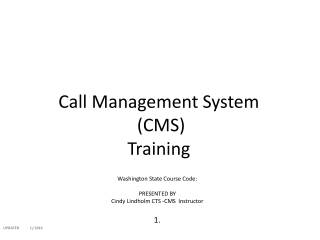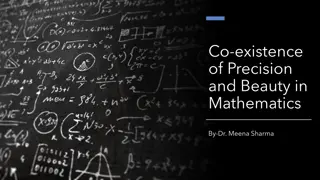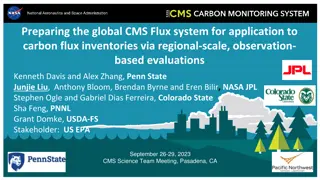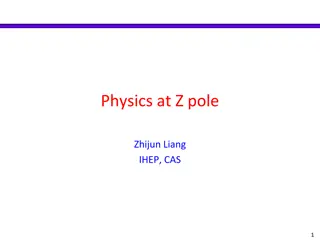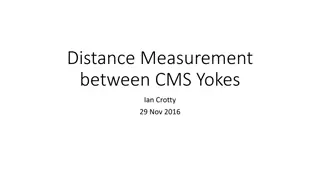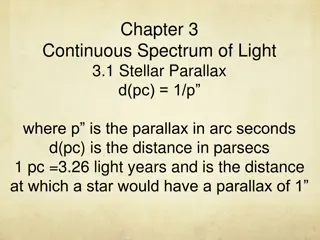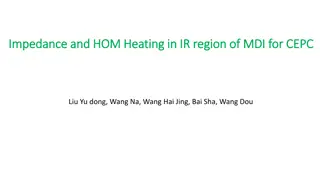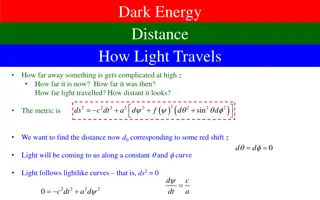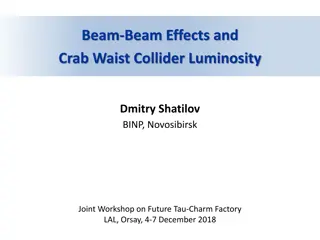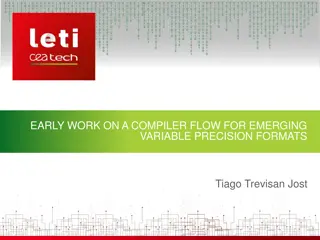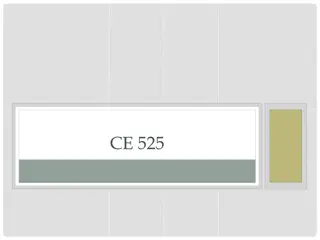Recommendations for Luminosity Precision in CMS AR 2020 Review
The CMS AR 2020 review highlights recommendations for achieving luminosity precision goals, emphasizing the breakdown of components, uncertainty budget allocation, and statistical error optimization. It stresses the importance of distinguishing between offline diagnostics and operational requirements while developing unified performance standards for vdM-calibratable subdetectors. Robustness against running condition changes is also emphasized for optimal system performance.
Download Presentation

Please find below an Image/Link to download the presentation.
The content on the website is provided AS IS for your information and personal use only. It may not be sold, licensed, or shared on other websites without obtaining consent from the author. Download presentation by click this link. If you encounter any issues during the download, it is possible that the publisher has removed the file from their server.
E N D
Presentation Transcript
Reviewers report of the CMS AR 2020 for BRIL and SAL (QFL) recommendations Daria Selivanova PhD Student at NRNU MEPhI, RU 16/09/2020 AR recommendations 1
Luminosity specific recommendations The committee recommends that for each luminosity sub-system overall 1% luminosity-precision goal be broken down into its main components Relative long-term stability and mutual consistency of independent luminosity measurements during physics running Non-linearity corrections vdM calibrations - Calibration transfer from the vdM to the physics regime A tentative uncertainty budget needs to be assigned to each, helping to identify some of the limitations and trade-offs affecting the design. The overall optimization should aim at a statistical error that is negligible compared to the corresponding systematic uncertainty for each component separately. 16/09/2020 AR recommendations 2
Luminosity specific recommendations The committee recommends to distinguish clearly between Requirements driven by offline diagnostics in the physics regime. Operational/online requirements Requirements related to the ultimate offline-luminosity precision in 1. vdM scans 2. Routine physics operation Here the statistical requirements are most stringent for the study of bunch- by-bunch dependent biases, e.g. the characterization of BCID-dependent background or non-linearities Such an approach to be useful not only to optimize the detector layout and the front-end electronics design, but also to show where the various measurement methods stand with respect to the overall 1% precision goal 16/09/2020 AR recommendations 3
Luminosity specific recommendations The committee recommends to develop a unified, BRIL-wide set of functional/performance requirements for all the vdM-calibratable subdetectors The azimuthal symmetry and the redundancy of the geometrical coverage The statistical precision required both at the peak of the on-axis scans ( ~ 0.5) and in the tails of the off-axis scans, at leas 3 orders of magnitude lower rate compared to the peak The trade-offs between statistical reach, sensor radial position and radiation- induced detector ageing The trade-offs between statistical reach, sensor radial size (hence capacitance) and FE response 16/09/2020 AR recommendations 4
Luminosity specific recommendations It is strongly recommended to review and document the robustness of all the luminosity subsystems against changes in running conditions and in parameters such as electronic thresholds, noise levels or dying channels. This is particularly crucial for the luminometers that are based on CMS subdetectors used for physics data-taking. For the new systems still in the design phase, the simulation studies should characterize the robustness against incremental system failures (e.g. to what extent the luminosity precision will be affected when losing channels or when the system deteriorates in any other way during Phase-2). The simulation should also investigate the effects of high pile-up on the front-end electronics that might have an important impact on the linearity of the response. 16/09/2020 AR recommendations 5
SAL specific recommendations The committee welcomes the studies of a Quartz-fiber stand alone luminometer due to some obvious advantages, however recognizes some challenges that need to be addressed. 1. To provide the necessary cooling to the sensors the following options should be investigated: Venturi tubes and thermoelectric coolers. Both allow for relatively efficient cooling in small volumes. 2. In order to minimize crossing-angle-related biases, the detector should be designed to be azimuthally symmetric. This implies at least 4 sensors per side. Some redundancy is desirable and hence a detector with 6 to 8 sensors per side is recommended. 16/09/2020 AR recommendations 6
SAL specific recommendations The committee welcomes the studies of a Quartz-fiber stand alone luminometer due to some obvious advantages, however recognizes some challenges that need to be addressed. 3. A sufficient signal-to-noise (S/N) ratio at low luminosity, in particular in the tails of the vdM scans, needs to be demonstrated. This could be achieved by installing a QFL prototype in the CMS cavern during Run 3. 4. It was shown that signals of different amplitudes will be generated in the detector. Such low amplitude signals can add up in a single channel to larger signals which cross the threshold. This effect will be a contribution to the non-linearity of the detector and needs to be carefully studied. 16/09/2020 AR recommendations 7
SAL specific recommendations The committee welcomes the studies of a Quartz-fiber stand alone luminometer due to some obvious advantages, however recognizes some challenges that need to be addressed. 5. Due to radiation effects, it is essential to monitor the detector stability by frequent calibrations, ideally once in every inter-fill period. The combination of the Cerenkov conversion efficiency, of potential changes in the Cerenkov spectrum and in the optical transmission of the fibres, and of drifts in photosensor gain, would be best monitored using a radioactive source close to the W-Cu converter. This could be achieved either: by embedding drops of Bi207 on the beam-line end of the fibre bundle, or by using the existing HF source. In either case the S/N ratio of the calibration signal is likely to prove a key issue. Not only should a sufficient signal be demonstrated in laboratory tests: the S/N ratio must also remain adequate after years of activation of the detector by pp- collision debris. While the source-induced signal must be large enough to provide robust calibrations, it must remain small enough not to mask the luminosity signal proper in the tails of off-axis vdM scans. 16/09/2020 AR recommendations 8
SAL specific recommendations The committee welcomes the studies of a Quartz-fiber stand alone luminometer due to some obvious advantages, however recognizes some challenges that need to be addressed. 5. Due to radiation effects, it is essential to monitor the detector stability by frequent calibrations, ideally once in every inter-fill period. If neither of the above-mentioned radioactive sources proves usable at the beam-line end of the fibres, the gain of each photosensor could still be monitored by depositing a drop of Bi207 on a small quartz converter fixed to the photosensor sensor window close to the arrival point of the fibre bundle. In this case, the optical transmission of the fibre could perhaps be monitored by routing a calibration-fibre loop along the signal-fibre bundle from a location close to the photosensor to the beam-line and back, and using a LED- or laser-based light source to monitor the round-trip light attenuation in the calibration fibre. An early experimental validation of the source-based calibration technique under realistic conditions, perhaps using the above-mentioned QFL prototype in the CMS cavern during Run 3, is strongly encouraged. 16/09/2020 AR recommendations 9
SAL specific recommendations The committee welcomes the studies of a Quartz-fiber stand alone luminometer due to some obvious advantages, however recognizes some challenges that need to be addressed. 6. It is recommended to equip those photosensors that will be movable, with a precision position measurement system which will be very useful to perform checks or during special runs where the sensors will have to be moved within short intervals. 7. The readout electronics should be designed such that hits in neighbouring BC slots (25ns) can be tolerated. 16/09/2020 AR recommendations 10
Thank you for attention 16/09/2020 AR recommendations 11


